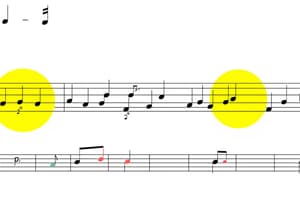Podcast
Questions and Answers
What is the function of the vii°/V chord in the vii°/V - V - I progression?
What is the function of the vii°/V chord in the vii°/V - V - I progression?
- A diminished chord
- A secondary tonic
- A secondary dominant (correct)
- A major chord
How many chords are typically used in a 12-bar blues progression?
How many chords are typically used in a 12-bar blues progression?
- 2
- 4
- 5
- 3 (correct)
What is the typical time signature of a 12-bar blues progression?
What is the typical time signature of a 12-bar blues progression?
- 3/4
- 2/4
- 4/4 (correct)
- 6/8
What mode is the i - IV progression commonly found in?
What mode is the i - IV progression commonly found in?
What is the purpose of chromatic chord progressions?
What is the purpose of chromatic chord progressions?
What is the function of a cadence in music?
What is the function of a cadence in music?
What is the characteristic of an authentic cadence?
What is the characteristic of an authentic cadence?
What type of cadence is characterized by a progression from the subdominant to the tonic?
What type of cadence is characterized by a progression from the subdominant to the tonic?
What is the purpose of analyzing cadences in music theory and composition?
What is the purpose of analyzing cadences in music theory and composition?
What is the result of familiarizing yourself with common chord progressions?
What is the result of familiarizing yourself with common chord progressions?
What is a fundamental component of music?
What is a fundamental component of music?
What type of chord progressions are built using the seven chords that naturally occur within a given key?
What type of chord progressions are built using the seven chords that naturally occur within a given key?
What is the ii - V - I progression also known as?
What is the ii - V - I progression also known as?
What type of chord progressions introduce chords that do not naturally occur within the key?
What type of chord progressions introduce chords that do not naturally occur within the key?
What is the purpose of secondary dominant chords in a progression?
What is the purpose of secondary dominant chords in a progression?
In the key of C major, what chords would be used in the vi - IV - I - V progression?
In the key of C major, what chords would be used in the vi - IV - I - V progression?
What is the function of the V/V chord in a V/V - V - I progression?
What is the function of the V/V chord in a V/V - V - I progression?
What is the result of using secondary dominant chord progressions in a diatonic progression?
What is the result of using secondary dominant chord progressions in a diatonic progression?
What type of atmosphere is often created by the plagal cadence in minor keys?
What type of atmosphere is often created by the plagal cadence in minor keys?
What is the characteristic of a half cadence?
What is the characteristic of a half cadence?
What is the purpose of deceptive cadences in music?
What is the purpose of deceptive cadences in music?
What is the benefit of recognizing different types of cadences?
What is the benefit of recognizing different types of cadences?
What is the first step in recognizing chord progressions by ear?
What is the first step in recognizing chord progressions by ear?
What is a triad in music?
What is a triad in music?
What is the purpose of ear-training exercises for chord progressions?
What is the purpose of ear-training exercises for chord progressions?
What is a chord voicing?
What is a chord voicing?
What is the purpose of recognizing common chord progressions?
What is the purpose of recognizing common chord progressions?
What is a modal chord progression?
What is a modal chord progression?
What type of chord progressions involve chords with additional tones, such as 7th, 9th, or 11th chords?
What type of chord progressions involve chords with additional tones, such as 7th, 9th, or 11th chords?
What type of chord progressions introduce chromatic alterations to the basic diatonic chords?
What type of chord progressions introduce chromatic alterations to the basic diatonic chords?
What is an excellent way to reinforce chord progression recognition skills?
What is an excellent way to reinforce chord progression recognition skills?
What should you listen to when developing your ear for recognizing altered progressions?
What should you listen to when developing your ear for recognizing altered progressions?
Why is it important to choose songs from various genres and levels of difficulty when transcribing chords?
Why is it important to choose songs from various genres and levels of difficulty when transcribing chords?
What can you use to slow down playback speed when transcribing chords?
What can you use to slow down playback speed when transcribing chords?
What is the result of regularly practicing chord progression recognition?
What is the result of regularly practicing chord progression recognition?
What should you do to become a proficient chord progression recognizer?
What should you do to become a proficient chord progression recognizer?
Flashcards are hidden until you start studying
Study Notes
Recognizing Common Chord Progressions
- Chord progressions are essential in music, providing structure, tension, and release, and are a fundamental skill for musicians and composers.
- Diatonic chord progressions are built using the seven chords that naturally occur within a key.
- Common diatonic progressions include:
- I - IV - V (e.g., C - F - G in the key of C major)
- ii - V - I (e.g., Dm7 - G7 - Cmaj7 in the key of C major)
- vi - IV - I - V (e.g., Am - F - C - G in the key of C major)
Secondary Dominant Chord Progressions
- Secondary dominant chord progressions add extra color and tension to a diatonic progression by introducing chords that do not naturally occur within the key.
- Common secondary dominant progressions include:
- V/V - V - I (e.g., D7 - G7 - C in the key of C major)
- vii°/V - V - I (e.g., Bdim7 - G7 - C in the key of C major)
Blues Chord Progressions
- Blues music is characterized by a specific chord progression known as the 12-bar blues.
- The 12-bar blues progression consists of three chords played in a specific order, usually in a 4/4 time signature.
- The most common progression is:
- I - I - I - I
- IV - IV - I - I
- V - IV - I - V
Modal Chord Progressions
- Modal chord progressions are commonly found in music that follows a modal scale, such as Dorian, Phrygian, or Mixolydian modes.
- Common modal progressions include:
- i - IV (e.g., Dm - G in the key of D Dorian)
- iii - VI (e.g., G - C in the key of E Phrygian)
Chromatic Chord Progressions
- Chromatic progressions use chords that do not have a diatonic relationship within a given key.
- Common chromatic progressions include:
- I - bVII - IV - bVI (e.g., E - D - A - C in the key of E)
- iiø7 - V7 - Imaj7 (e.g., Dm7b5 - G7 - Cmaj7 in the key of C)
Analyzing Cadences
- Cadences are a sequence of chords that signal the end of a musical phrase or section.
- Cadences provide a sense of resolution or finality to the listener.
- Common types of cadences include:
- Authentic cadences (V - I)
- Plagal cadences (IV - I)
- Half cadences (V - x or IV - x)
- Deceptive cadences (V - x or V/vi-vi)
Ear Training Exercises for Chord Progressions
- Ear training exercises can help musicians recognize and identify chord progressions by ear.
- Exercises include:
- Basic triad recognition (major, minor, diminished, and augmented)
- Chord voicings (root position, first inversion, and second inversion)
- Common chord progressions (I-IV-V, ii-V-I)
- Modal chord progressions (ii-V-I in Dorian mode, IV-V-I in Mixolydian mode)
- Extended chord progressions (7th, 9th, or 11th chords)
- Altered chord progressions (chromatic alterations to diatonic chords)
- Transcription exercises (transcribing chords from recorded music)
Studying That Suits You
Use AI to generate personalized quizzes and flashcards to suit your learning preferences.




